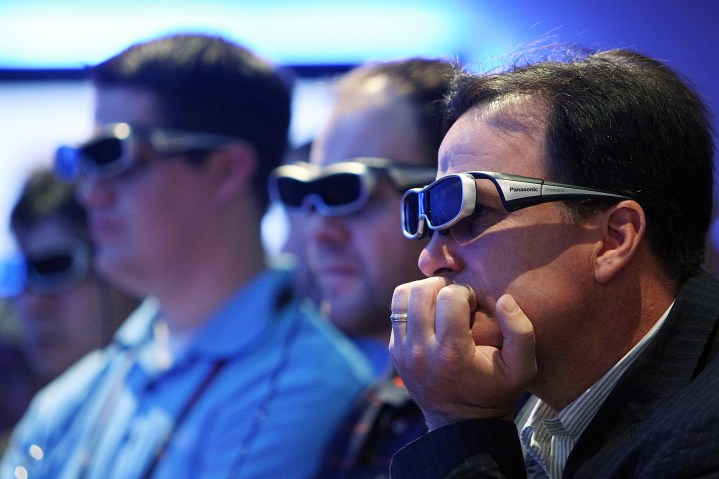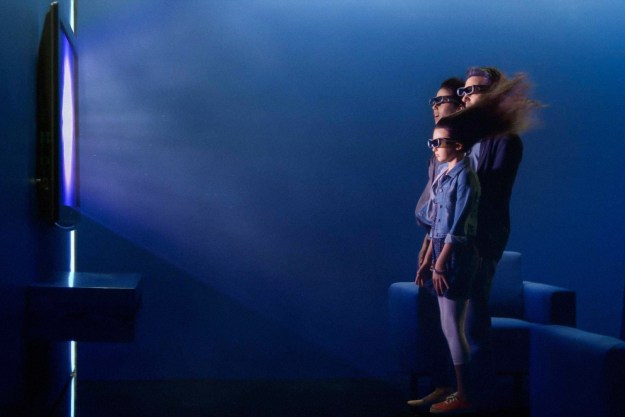The 3D revolution started a little over a decade ago. It didn’t last long.
While television manufacturers like Samsung, LG, and Panasonic bet big on the technology — and some top filmmakers, including James Cameron, made a convincing case for it in theaters — it had a lifespan of just seven years. So what happened? Why did 3D fail to catch on?
The obvious answer, of course, is the glasses. While less an issue in theaters, home users felt foolish having to wear a special set of glasses to watch TV. It didn’t help that most were bulky and had tech issues, as well.
But the fall of 3D goes much deeper than headgear. While the technology was the darling of marketing departments and heralded at CES as the next big thing, it failed to win some key supporters and failed consumers on several levels, hastening its demise.
To fully understand what went wrong with 3D, it helps to know the technology’s most recent history.
The 3D revolution
The breakout year for 3D came in 2010. James Cameron had released Avatar a few weeks prior and audiences were captivated by the technology, which was carefully incorporated into the film. Within three months, Panasonic and Samsung had both released their first 3D sets, which had been years in the making.
The new feature carried quite a premium. A 55-inch Samsung set ran for $3,300, plus another $150 for each pair of shutter glasses, which were required to watch 3D programming. Panasonic charged $2,500 for a 50-inch set, which came with one set of shutter lens glasses (others cost $150 per pair). If you wanted to watch a 3D Blu-ray disc, that player would run another $400.
(Samsung declined to be interviewed for this story. LG, another leader in 3D TVs, did not respond in a timely manner.)

For the next two years, new 3D sets were rolled out regularly at CES. By 2013, as sales struggled and 4K and OLED began their rise, it was tough to find one. Vizio stopped making 3D sets that year. Samsung held on until 2016. And by 2017, Sony and LG both abandoned 3D, removing it from all of their sets.
To put things in perspective: In 2012, 3D TVs made up 23% of total TV sales dollars, according to The NPD Group. The numbers consistently went down from there and by 2016, they were responsible for just 8% of sales.
Networks that were hoping to support 3D programming didn’t even last that long. DirecTV canceled its 3D channel in 2012 and ESPN pulled the plug on its 3D channel in 2013. The motion picture industry made 3D moves for a few more years, even giving the technology one last big push with 2015’s Star Wars: The Force Awakens, before giving up on it.
The problem with the glasses
While 3D TV’s problems can’t all be tied to the glasses, they certainly shoulder some of the blame. Beyond the odd experience of having to wear specific eyewear in your home to see the effects, there were technical issues that marred the experience.
In the race to be first to market, Samsung and Panasonic both opted to use active shutter lenses, which presented the onscreen image intended for the left eye while blocking the right eye’s view, then vice versa, at a speed so rapid that the wearer’s brain interpreted them as 3D. They were expensive, heavy, and would frequently run out of power (ruining the effect). There were also occasional syncing issues with the TV.

(Passive glasses, like the ones worn at a movie theater, cost almost nothing, were much lighter and didn’t have any of the power/sync issues, but it would be a year or two before those became part of the sets.)
That gave initial users a bad experience. And early adopters can act as either evangelists for a new technology or vocal detractors. In this case, they created a buzz the industry couldn’t overcome.
The theater experience versus the home experience
It’s one thing to see a 3D film in a theater. Images pop off the screen and, if the technology is used right, can make you feel like you’re part of the film’s world. In the living room, things aren’t quite so magical.
Bigger is better when it comes to 3D — and even a 70-inch set couldn’t compare to a theater screen when it came to depth, an essential part of the 3D illusion. Studios could compensate for that by doing a slight reconversion in post-production before releasing it for home video. But few wanted to pay that expense, given the fledgling sales of the sets.
The issue was very similar when it came to television programs specifically made for 3D.
“Nobody looked at quality, and if a viewer watched one bad show, it damned the technology.”
Sky TV in the U.K. was one of the few television programmers to go all-in on 3D production, curating high-quality 3D content such as a David Attenborough documentary and a Kylie Minogue concert, as well as some of the 2012 Summer Olympics. Ultimately, though, the network couldn’t license that content to other channels, since so few showcased 3D content, and it shut down.
Other major production studios generally took a wait and see attitude. That opened the gates for smaller groups to shoot content. The smaller production budgets of those companies, though, resulted in subpar 3D effects.
“Nobody looked at quality, and if a viewer watched one bad show, it damned the technology,” says Steve Schklair, a producer and cinematographer and CEO of 3ality Technica, which specializes in high-definition, live-action stereoscopic digital 3D.
Finances and the artistic divide
The very early days of 3D were costly, with extended crew, production shoot times, and more. But by the time 3D TVs and films arrived, those costs were fairly minimal. Schklair says including 3D would add around $1 million to a film’s budget (less in some cases). For a $150 million film, that’s a drop in the bucket, though it’s much more significant for smaller productions.
Those lower costs are why so many films incorporated 3D at the beginning of the decade. The problem was: It often wasn’t the directors making that decision. It was studio heads and marketing officials, who felt they could convince certain audiences to pay extra to see a 3D version of the film.

That led to some clashes in the filmmaking process.
“All movies boil down to creative,” says Schklair. “There were some directors — like Ridley Scott and Jim Cameron — who were shooting [3D] as a tool to help them tell their story. Other directors were shooting it because the marketing team made them. They shot their movie the way they normally would because the 3D didn’t mean anything to them. If you’re going to make people wear glasses, you have to give them something for it. … 3D didn’t make a bad script any better.”
It was these mandates that made “eye-poking” 3D come into vogue. Directors, under orders to utilize 3D, would have things jump out of the screen to try to make audiences dodge. (Horror films, in particular, favored this trick.) It was a fun effect the first time or two you experienced it, but it wasn’t enough to justify higher ticket costs or a premium TV.
The NFL
Pre-recorded shows and movies were one thing, but many people felt sports would be the real silver bullet for 3D TV. The technology seemed perfect for letting people feel like they were on the field. And while some sports organizations, like the NBA and several soccer leagues, gave 3D a real chance, the NFL never did more than dip its toes in the water.
“The NFL might be running 47 cameras in 2D,” says Schklair. “They’ve got sideline cameras, bench cams, goalpost cams, overhead cams. There are cameras everywhere when you watch TV. When they brought me in and said ‘we’ll shoot in 2D and 3D,’ they said ‘you get six camera positions’. Ultimately, that was the death of 3D — people trying to tell stories with 20% as many cameras as they are used to telling stories with.”
ESPN 3D tried as best as it could, showcasing 25 matches of the 2010 FIFA World Cup, 14 NBA games, the Wimbledon semifinals, and more. But it shut down in June 2012, citing “limited viewer adoption of 3D services to the home”.
“The production was superb, and feedback from those that watched was very positive. But, in the end, that alone wasn’t enough.”
“We operated ESPN 3D for three years, innovating and advancing the technology and production along the way,” the network told Digital Trends in a statement. “The production was superb, and feedback from those that watched was very positive. But, in the end, that alone wasn’t enough. Viewer demand and adoption of 3D services to the home simply didn’t reach a level that made business sense, and we opted to shift focus to other areas of technology and services.”
There were other technical challenges of 3D and live sports. 3D, for example, doesn’t work well with telephoto lenses, since those flatten an image. That meant 3D sports broadcasts were primarily forced to use wide shots, which don’t convey the emotion of the game like a closeup will.
Innovations that fell short
3D TVs did try to innovate. Many manufacturers tried to transition to auto-stereo 3D, which would have done away with the need for glasses. A good idea, perhaps, but most used the same technology — so they all had the same shortcoming: Where you sat and the position you held your head made all the difference in how effective the 3D effects were.
Eye-tracking technology was also explored, which showed promise, but that could only accommodate one or two viewers at a time — something that didn’t work well for living room TVs.
Dead and gone?
While the corpse of 3D is just going cold, the technology has shown zombie-like qualities before. So it’s natural to wonder if, like VR, 3D could rise again someday.
Anything’s possible, of course. A sequel to Avatar is due in late 2021 and that could spur a new push for 3D by audiences. And AR/VR headsets are already equipped to produce 3D effects.
Should the pandemic go even longer than feared, keeping people from concerts and other live events, that could spur demand as well. The technology could re-create the live entertainment experience slightly better than a YouTube stream or Zoom call.
But 3D in the living room? Even people who worked in the industry say that’s unlikely.
“There are no more 3D TVs available and I don’t think there’s a groundswell of support for them,” says Schklair. “I don’t see it coming back.”
Editors' Recommendations
- You Asked: 3D VR, QDEL technology, and TV size vs. quality
- Samsung, Google are attacking Dolby Atmos’ monopoly on 3D sound, and it’s going to get ugly
- LG’s fully wireless StanbyMe is the touchscreen TV you didn’t know you wanted
- Super Mario 3D World made it to Switch, but other Wii U games are still stranded
- Los Angeles-based Czinger is 3D-printing a 1,232-hp hybrid hypercar




